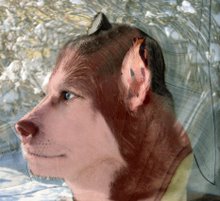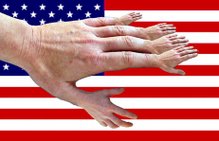
Secret languages, whether spoken by children, gypsies, con men, dissidents, criminals and even solely by one gender (the language of women, known as Nushu in China), have been around for a long time. After all, Pig Latin is known to almost every kid born in the U.S., and if you meet people who aren't native English speakers, and explain the concept, you'll probably get some stories about something similar in another language, from childhood. And likely each will smile as he or she remembers.
Long ago I encountered a variety of secret language known as "Carny talk," the secret language of carnival workers, among some Miami, Florida youths. It's lately mutated into a Rap-related sort of thing known as "izzle." But back then, the rules were simple, if slightly varied: after each initial consonant "ee-ah-z" was inserted. Shoes became "shee-ah-zoes." A fine car was a feeazine ceeazar, and police were either peeazolice or peeazoleeazice, depending, I guess, on whether you were in a hurry.
Into this group had alit one fellow who had learned a variant of this lingo or argot, which he constructed by a similar rule. The add-in was "ih-thug" with a voiced "th" as in "the." Beer became bithageer. Eagerly they all taught each other all their variations.
And began mixing the two variant constructs in their language. "Theazats a fithagine weazomithagon" was not unusual to hear. ("That's a fine woman.") I was usually, but not always, lost. I deciphered some of it.
It took me a long time to reconstruct all that, because when I learned later the "formal" rules of Carny, there was no ih-thug, it was all eaz-uh. This was the form popularized by Murray the K, I later learned.
Once I was in a car with a Frenchman and a Belgian, and with no warning, just for kicks, I began speaking Carny. "Wheahzen weaze geazet teazo theaze beazar, eazi'm dreazinking a beazeer." Silence. They both turned and looked at me with great horror on their faces. I couldn't keep a straight face and started laughing, looking at their expressions. They thought they had lost their command of English!
A few years later I recalled all that, and tried the same thing with my sister-in-law. To my utmost shock, she began rattling off Carny talk so fast I couldn't keep up! I had no idea she would ever have learned this! I guess she then enjoyed the look on my face. As it turned out, she had been in range of Murray the K's radio shows where she grew up; I never had been.
-------------------------------------------------------------------------
Long ago I encountered a variety of secret language known as "Carny talk," the secret language of carnival workers, among some Miami, Florida youths. It's lately mutated into a Rap-related sort of thing known as "izzle." But back then, the rules were simple, if slightly varied: after each initial consonant "ee-ah-z" was inserted. Shoes became "shee-ah-zoes." A fine car was a feeazine ceeazar, and police were either peeazolice or peeazoleeazice, depending, I guess, on whether you were in a hurry.
Into this group had alit one fellow who had learned a variant of this lingo or argot, which he constructed by a similar rule. The add-in was "ih-thug" with a voiced "th" as in "the." Beer became bithageer. Eagerly they all taught each other all their variations.
And began mixing the two variant constructs in their language. "Theazats a fithagine weazomithagon" was not unusual to hear. ("That's a fine woman.") I was usually, but not always, lost. I deciphered some of it.
It took me a long time to reconstruct all that, because when I learned later the "formal" rules of Carny, there was no ih-thug, it was all eaz-uh. This was the form popularized by Murray the K, I later learned.
Once I was in a car with a Frenchman and a Belgian, and with no warning, just for kicks, I began speaking Carny. "Wheahzen weaze geazet teazo theaze beazar, eazi'm dreazinking a beazeer." Silence. They both turned and looked at me with great horror on their faces. I couldn't keep a straight face and started laughing, looking at their expressions. They thought they had lost their command of English!
A few years later I recalled all that, and tried the same thing with my sister-in-law. To my utmost shock, she began rattling off Carny talk so fast I couldn't keep up! I had no idea she would ever have learned this! I guess she then enjoyed the look on my face. As it turned out, she had been in range of Murray the K's radio shows where she grew up; I never had been.
-------------------------------------------------------------------------
A few years ago, I did some research on "Carny talk," and at that time came up with a few web pages, which was the best I could find on the internet:
http://www.linguistlist.org/issues/5/5-764.html#1
http://lloyd.emich.edu/cgi-bin/wa?A2=ind9710e&L=linguist&P=3270
(those are pretty good, and with bibliography)
So I decided to revisit this fascinating topic, and checked around on the internet using Google and Wikipedia. Google mostly returned the same seven year old links, above. Wikipedia is a mess. The best they have is this article on Argot.
I occasionally contribute to Wikipedia. I spent some time adding judiciously to this one, crosslinking some other articles, and calling attention to the information in the linguistlist.org link mentioned above. In my view, all the various Pig Latins, Carnys, and such should be connected with one article. They properly distinguish between argot and jargon.
In the meantime, I found the original author of one of the 1994 summary pages has gone on to editing The SpecGram.
Nushu - Women's language Language Games - Wikipedia
The end of Nushu
(A tip o' the hat will be given to any who identify the mystery carny in the illustration!)
http://www.linguistlist.org/issues/5/5-764.html#1
http://lloyd.emich.edu/cgi-bin/wa?A2=ind9710e&L=linguist&P=3270
(those are pretty good, and with bibliography)
So I decided to revisit this fascinating topic, and checked around on the internet using Google and Wikipedia. Google mostly returned the same seven year old links, above. Wikipedia is a mess. The best they have is this article on Argot.
I occasionally contribute to Wikipedia. I spent some time adding judiciously to this one, crosslinking some other articles, and calling attention to the information in the linguistlist.org link mentioned above. In my view, all the various Pig Latins, Carnys, and such should be connected with one article. They properly distinguish between argot and jargon.
In the meantime, I found the original author of one of the 1994 summary pages has gone on to editing The SpecGram.
Nushu - Women's language Language Games - Wikipedia
The end of Nushu
(A tip o' the hat will be given to any who identify the mystery carny in the illustration!)




2 comments:
Pig Latin makes my head hurt enough.
Just wanted to let you know that I referenced this blog post in my new book, The Secret History of Carnival Talk. It explores the origins and evolution of the carny argot, along with my own personal story of learning it from my grandparents, who travelled with a carnival in 1937. You can learn more at http://carnivaltalk.wordpress.com.
Post a Comment